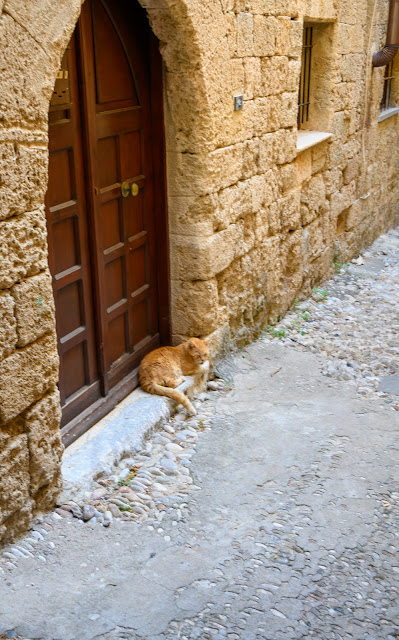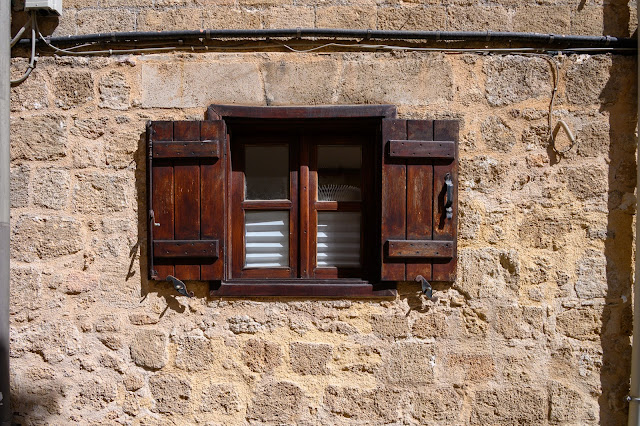Welcome to the Medieval times.
Gone are the white washed buildings.
Gone are the Cycladic architecture.
Gone are the churches at every corner.
Gone are the blue and white windmills.
Instead, you are faced with old stone structures, castles, and huge forts.
Rhodes is part of the Dodecanese Islands. A group of approximately fifteen large islands and 150 smaller islands known for their medieval castles, Byzantine churches, beaches and ancient archaeological sites, with Rhodes being the largest of all.
The old town of Rhodes has been declared a UNESCO World Heritage Site and is considered one of the best preserved medieval settlements in the world.
To enter the city, once off the ship, one has no choice but to to walk through this imposing gate called Marine Gate. This medieval gate was constructed in 1478. It is the main entrance from the harbor to the city. Therefore, it is also sometimes referred to as the Sea Gate.
This is when you reliaze you are no longer in the 21st century but have walked back into the Middle Ages.
Of course like any good visitors' attraction, one is led to the area which generates the most amount of cash; shops and restaurants. Henceforth, one has to pass this area before being able to see the real gothic structures.
A few steps into the city and one finds oneself in Ippokratous Square. In the center of the square stands an ornamental fountain, which, along with a grand staircase from the south west section, is the only remaining evidence of the Castellania, an important building constructed by the Knights Hospitaller in the 14th century.
Before I go any further, I must say that this is an island that loves its cats. Almost all the houses we walked by had a bowl of cat food set outside the entrance just for the ferile cats hanging around. I, of course had to take their photo as I saw them.
The Mosque of Suleiman (below) was built by the sultan in 1522 to celebrate the victory of the Turkish over the Knights Hospitaller. The Knights had established themselves in Rhodes in 1307 and their possession of the island was confirmed by Pope Clement V in 1309.
The building was re-constructed in 1808, following a damage, and its striking minaret sadly had to be removed in 1989, as it was deemed unsafe. However, to this day the rose colored stone exterior and classic Ottoman style is striking and adds significantly to the ambiance of the Old City.

The Street of the Knights is one of the best-preserved medieval streets in Europe. The street runs from the square to the Palace of the Grand Master. The stone-paved street replaced an ancient road that connected the town to the Acropolis of Rhodes. The buildings found along the street include inns that were constructed during the 15th and the 16th centuries.
But for me what attracted me the most wasn't just the intricate carvings and ornate facades of these historic buildings but the various styles of doors as well.
The Turkish School (below) was built in 1856 during the Ottoman Empire reign. The school was destroyed by an Earthquake in 1898 and rebuilt into this one.

"The Palace of the Grand Master of the Knights of Rhodes is also known as the castle. According to archeologists, the palace sits on the site of an ancient temple dedicated to the Sun-god Helios. The medieval Gothic palace was originally built in the seventh century. Over its history, it has served as a Byzantine citadel, a palace, a fortress, and as headquarters. It sits on the highest point in Rhodes.
During the 14th century, the Knights Hospitaller used the palace as an administrative center and the Grand Master's palace. The Ottoman Empire captured the island in 1522, and the palace became a command center and fortress. In the early 20th century, Italian King Victor Emmanuel III and Benito Mussolini used the palace as a holiday home.
In 1948, Rhodes was transferred to Greek rule, and the palace was turned into a museum."
The palace is arranged around a central courtyard. Hellenistic and Roman period statues line the courtyard.
Below is a re-enactment of how the Knights used their base in Rhodes to harass the infidels by becoming the proverbial thorn in the side of the Turks.😉
Ceramic illuminated script showing an excerpt from an account by Jacobi Fontani which described the Ottoman siege of Rhodes in 1522.
Inevitably, no matter what route or street you take, in this old section of town, you end up back in the areas with more shops and restaurants. After all 2.6 million people visited Rhodes, just last year, and Greece relies heavily on tourism.
For me it was just another opportunity to shoot some candids.
The streets being so narrow, it is expected that you share them with the minivans and mopeds that fly by. It seems like everyone living or working in this area of town owns a moped.
Below is the Church of Holy Trinity originally built possibly sometime during the 15th century. It has a cruciform architecture and a tiled dome. Findings suggest that it was initially dedicated to Saint Michael and it was later converted to a mosque during the Ottoman occupation years.
We ended up doing almost a full circle of the old town and was back at the Ippokratous Square. Time for a sit down with a cold glass and admire what the square had to offer.
Honestly, there is so much to see just in the square that one could sit for hours and never get bored. But like all good things that must come to an end, the act of sitting at the cafe on the square came to an end and we commenced our walk around the rest of the area.
"Owing to its geographical location, as a gateway to the Aegean Sea, Rhodes has always had a vantage position on trade routes between the West and the East – well protected against both foreign invaders and corsairs sailing the Mediterranean waters. The early defense system of Rhodes dates back as far as the 4th century BC.
The medieval walled city of Rhodes covers a distance of four kilometers and includes 11 gates, some of which are open to the public."
"Saint Paul's Gate once served as an entry point to the city from the harbour of Mandraki and the De Naillac Pier.
A semi-cylindrical tower in the inner part of wall bears a marble sculpture of the coat of arms of the House of Grand Master d’Aubusson (1476-1503).
During World War Two, St. Paul’s Gate was hit heavily and almost fell. It was rebuilt early in the 1950s."
Mandraki Harbor has been a port since ancient times.The Knights of Rhodes moored their fleet in this harbor. Today, the harbor is home to modern yachts and three iconic medieval windmills. These ancient windmills used to grind grains brought from vessels that moored in the harbor. There used to be more windmills, possibly 13 or 14. Now only three remain, and they have been extensively renovated.
"Built on top of the fortess of St. Nicolaos in Mandraki Harbor, this lighthouse known as Agios Nikolaos was constructed by the French in 1863.Its flashing fourth-order white light was visible 14 miles (23 kilometers). The lower portion of the tower suffered damage and deterioration over the years and was for a time replaced by a skeleton beacon on which the original lantern was dispayed. The masonry tower was rebuild in 2007 and the lantern was restored and relighted with a 300mm optic manufactured by Tideland. Its range is 11 miles (18 kilometers)."
With one last look at Rhodes from the other side of the harbor the New Market or "Nea Agora" as it's officially called, is what catches my eye. It is a total contrast to the forts and stone structures in Old Town. The market hall was built in the 20th century by Italians.
So much diversity in such a small area.
If you are wondering why Rhodes is so different, architectually speaking, from the other two islands we visited, it is due to its location. Because of its strategic position, Rhodes was conquered successively by Turks, Persians, and Saracens. The history of Rhodes was primarily marked by the occupation from the Venetians in the Medieval times. The Knights of Saint John fortified the City of Rhodes with citadels, castles and built the Palace of the Grand Master.
In 1523, after a long siege, the Ottomans took control of the island, and remained there until 1912. During the First World War, Rhodes was taken by the Italians till 1943. The Italians contributed to the development of the island, with the renovation of important sites and the construction of nice buildings, In 1947, Rhodes and all Dodecanese islands became part of the Greek State.
Next stop will be another one of those Greek Islands that lure tourists on a daily basis. Bet you know which one I am referring to.





















































































































































0 comments:
Post a Comment